Nursing Care Plan: Atorvastatin for Wound Infections - Drug Therapy
VerifiedAdded on 2021/05/31
|9
|2382
|79
Report
AI Summary
This nursing care plan focuses on the administration of Atorvastatin for a patient with a history of type 2 diabetes and a suspected wound infection. The plan details the drug's pharmacodynamics and pharmacokinetics, including absorption, distribution, metabolism, and excretion, as well as potential drug interactions and adverse effects. It outlines the clinical decision-making process, encompassing assessment, implementation, and evaluation, alongside nursing responsibilities such as patient education and cultural considerations. The report emphasizes the importance of effective communication, respect for patient values, and the provision of comprehensive education on the patient's condition and medication regimen to facilitate recovery and improve health outcomes. The care plan also highlights the importance of monitoring the patient's compliance and addressing potential challenges related to the patient's medical history and cultural background.
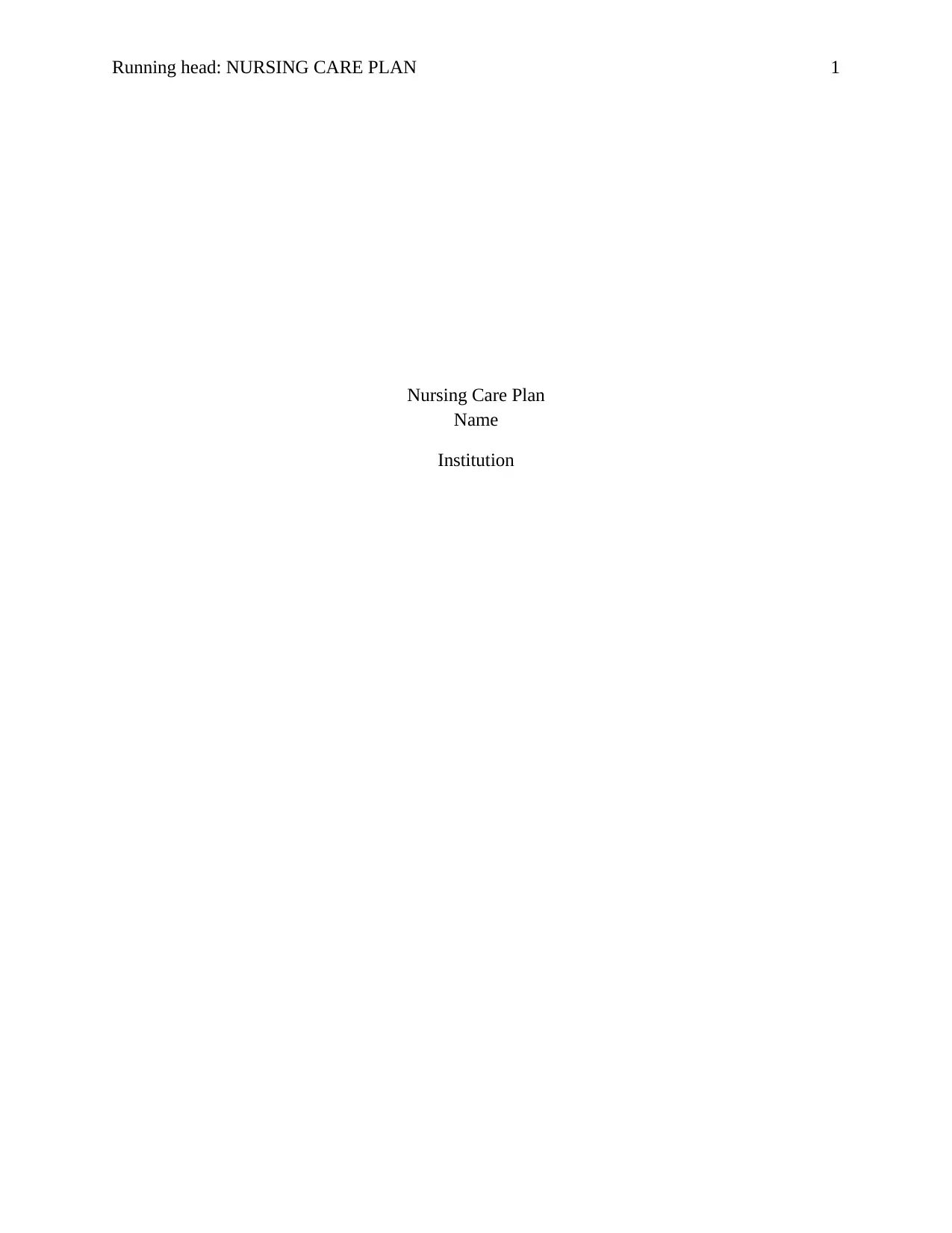
Running head: NURSING CARE PLAN 1
Nursing Care Plan
Name
Institution
Nursing Care Plan
Name
Institution
Paraphrase This Document
Need a fresh take? Get an instant paraphrase of this document with our AI Paraphraser
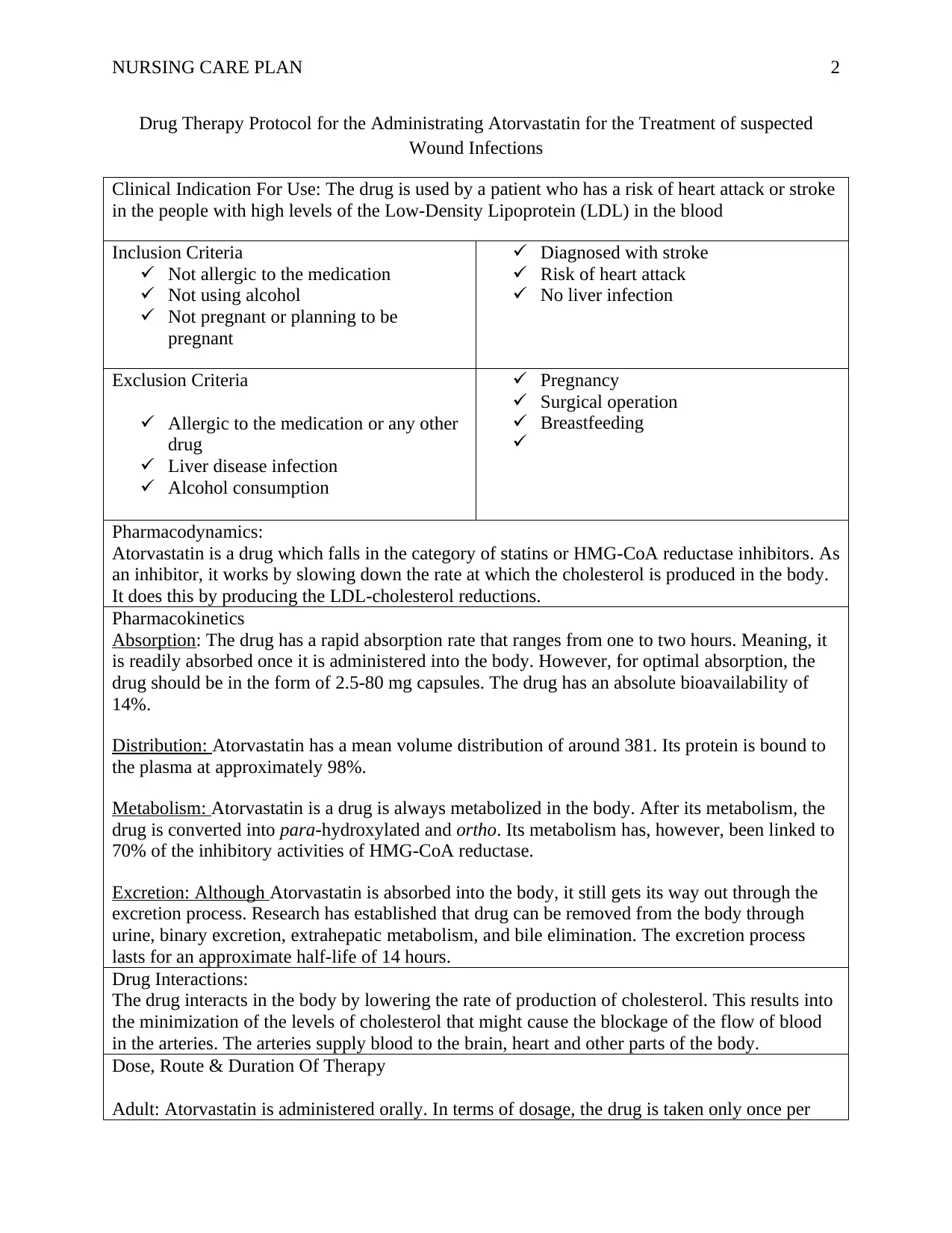
NURSING CARE PLAN 2
Drug Therapy Protocol for the Administrating Atorvastatin for the Treatment of suspected
Wound Infections
Clinical Indication For Use: The drug is used by a patient who has a risk of heart attack or stroke
in the people with high levels of the Low-Density Lipoprotein (LDL) in the blood
Inclusion Criteria
Not allergic to the medication
Not using alcohol
Not pregnant or planning to be
pregnant
Diagnosed with stroke
Risk of heart attack
No liver infection
Exclusion Criteria
Allergic to the medication or any other
drug
Liver disease infection
Alcohol consumption
Pregnancy
Surgical operation
Breastfeeding
Pharmacodynamics:
Atorvastatin is a drug which falls in the category of statins or HMG-CoA reductase inhibitors. As
an inhibitor, it works by slowing down the rate at which the cholesterol is produced in the body.
It does this by producing the LDL-cholesterol reductions.
Pharmacokinetics
Absorption: The drug has a rapid absorption rate that ranges from one to two hours. Meaning, it
is readily absorbed once it is administered into the body. However, for optimal absorption, the
drug should be in the form of 2.5-80 mg capsules. The drug has an absolute bioavailability of
14%.
Distribution: Atorvastatin has a mean volume distribution of around 381. Its protein is bound to
the plasma at approximately 98%.
Metabolism: Atorvastatin is a drug is always metabolized in the body. After its metabolism, the
drug is converted into para-hydroxylated and ortho. Its metabolism has, however, been linked to
70% of the inhibitory activities of HMG-CoA reductase.
Excretion: Although Atorvastatin is absorbed into the body, it still gets its way out through the
excretion process. Research has established that drug can be removed from the body through
urine, binary excretion, extrahepatic metabolism, and bile elimination. The excretion process
lasts for an approximate half-life of 14 hours.
Drug Interactions:
The drug interacts in the body by lowering the rate of production of cholesterol. This results into
the minimization of the levels of cholesterol that might cause the blockage of the flow of blood
in the arteries. The arteries supply blood to the brain, heart and other parts of the body.
Dose, Route & Duration Of Therapy
Adult: Atorvastatin is administered orally. In terms of dosage, the drug is taken only once per
Drug Therapy Protocol for the Administrating Atorvastatin for the Treatment of suspected
Wound Infections
Clinical Indication For Use: The drug is used by a patient who has a risk of heart attack or stroke
in the people with high levels of the Low-Density Lipoprotein (LDL) in the blood
Inclusion Criteria
Not allergic to the medication
Not using alcohol
Not pregnant or planning to be
pregnant
Diagnosed with stroke
Risk of heart attack
No liver infection
Exclusion Criteria
Allergic to the medication or any other
drug
Liver disease infection
Alcohol consumption
Pregnancy
Surgical operation
Breastfeeding
Pharmacodynamics:
Atorvastatin is a drug which falls in the category of statins or HMG-CoA reductase inhibitors. As
an inhibitor, it works by slowing down the rate at which the cholesterol is produced in the body.
It does this by producing the LDL-cholesterol reductions.
Pharmacokinetics
Absorption: The drug has a rapid absorption rate that ranges from one to two hours. Meaning, it
is readily absorbed once it is administered into the body. However, for optimal absorption, the
drug should be in the form of 2.5-80 mg capsules. The drug has an absolute bioavailability of
14%.
Distribution: Atorvastatin has a mean volume distribution of around 381. Its protein is bound to
the plasma at approximately 98%.
Metabolism: Atorvastatin is a drug is always metabolized in the body. After its metabolism, the
drug is converted into para-hydroxylated and ortho. Its metabolism has, however, been linked to
70% of the inhibitory activities of HMG-CoA reductase.
Excretion: Although Atorvastatin is absorbed into the body, it still gets its way out through the
excretion process. Research has established that drug can be removed from the body through
urine, binary excretion, extrahepatic metabolism, and bile elimination. The excretion process
lasts for an approximate half-life of 14 hours.
Drug Interactions:
The drug interacts in the body by lowering the rate of production of cholesterol. This results into
the minimization of the levels of cholesterol that might cause the blockage of the flow of blood
in the arteries. The arteries supply blood to the brain, heart and other parts of the body.
Dose, Route & Duration Of Therapy
Adult: Atorvastatin is administered orally. In terms of dosage, the drug is taken only once per
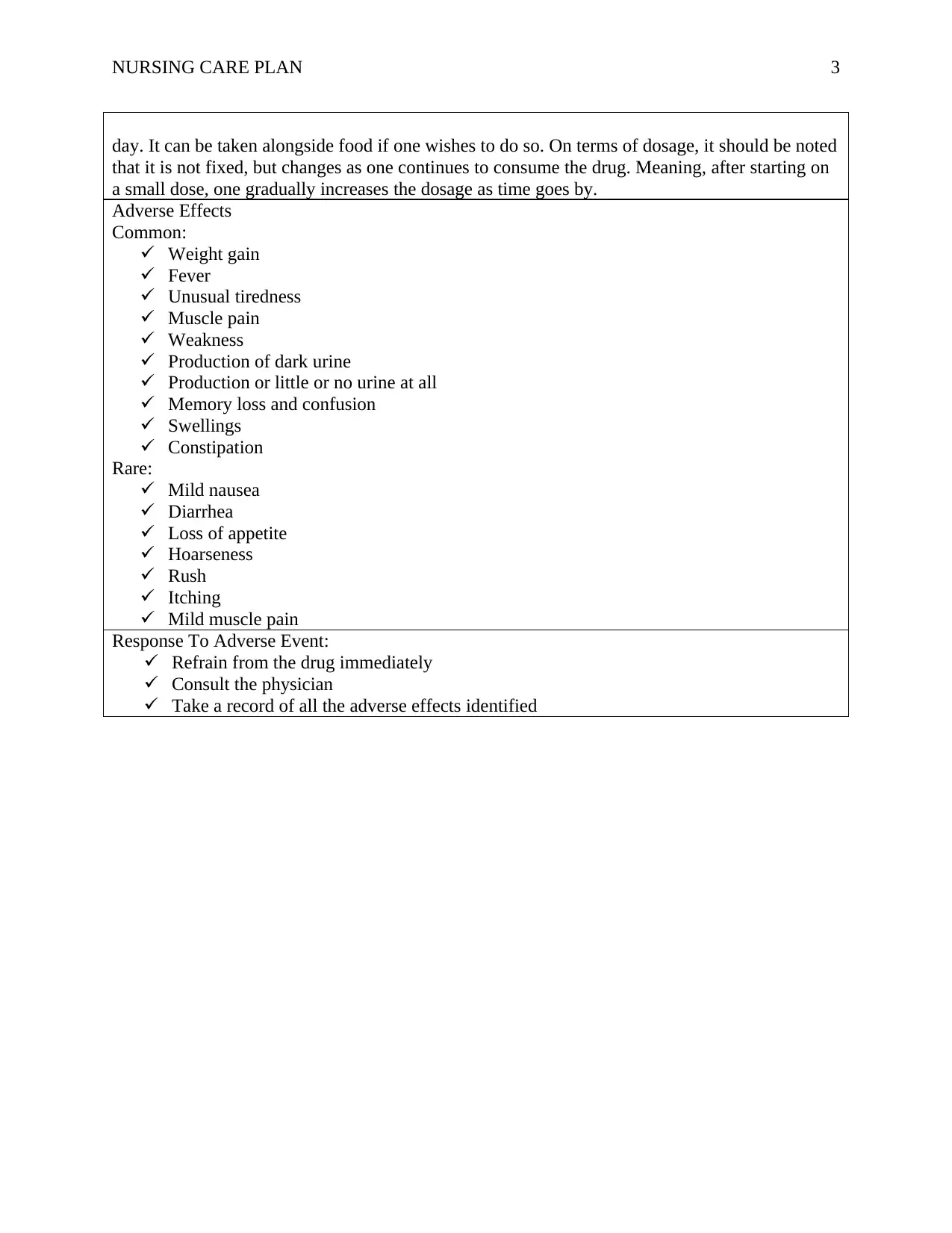
NURSING CARE PLAN 3
day. It can be taken alongside food if one wishes to do so. On terms of dosage, it should be noted
that it is not fixed, but changes as one continues to consume the drug. Meaning, after starting on
a small dose, one gradually increases the dosage as time goes by.
Adverse Effects
Common:
Weight gain
Fever
Unusual tiredness
Muscle pain
Weakness
Production of dark urine
Production or little or no urine at all
Memory loss and confusion
Swellings
Constipation
Rare:
Mild nausea
Diarrhea
Loss of appetite
Hoarseness
Rush
Itching
Mild muscle pain
Response To Adverse Event:
Refrain from the drug immediately
Consult the physician
Take a record of all the adverse effects identified
day. It can be taken alongside food if one wishes to do so. On terms of dosage, it should be noted
that it is not fixed, but changes as one continues to consume the drug. Meaning, after starting on
a small dose, one gradually increases the dosage as time goes by.
Adverse Effects
Common:
Weight gain
Fever
Unusual tiredness
Muscle pain
Weakness
Production of dark urine
Production or little or no urine at all
Memory loss and confusion
Swellings
Constipation
Rare:
Mild nausea
Diarrhea
Loss of appetite
Hoarseness
Rush
Itching
Mild muscle pain
Response To Adverse Event:
Refrain from the drug immediately
Consult the physician
Take a record of all the adverse effects identified
⊘ This is a preview!⊘
Do you want full access?
Subscribe today to unlock all pages.

Trusted by 1+ million students worldwide
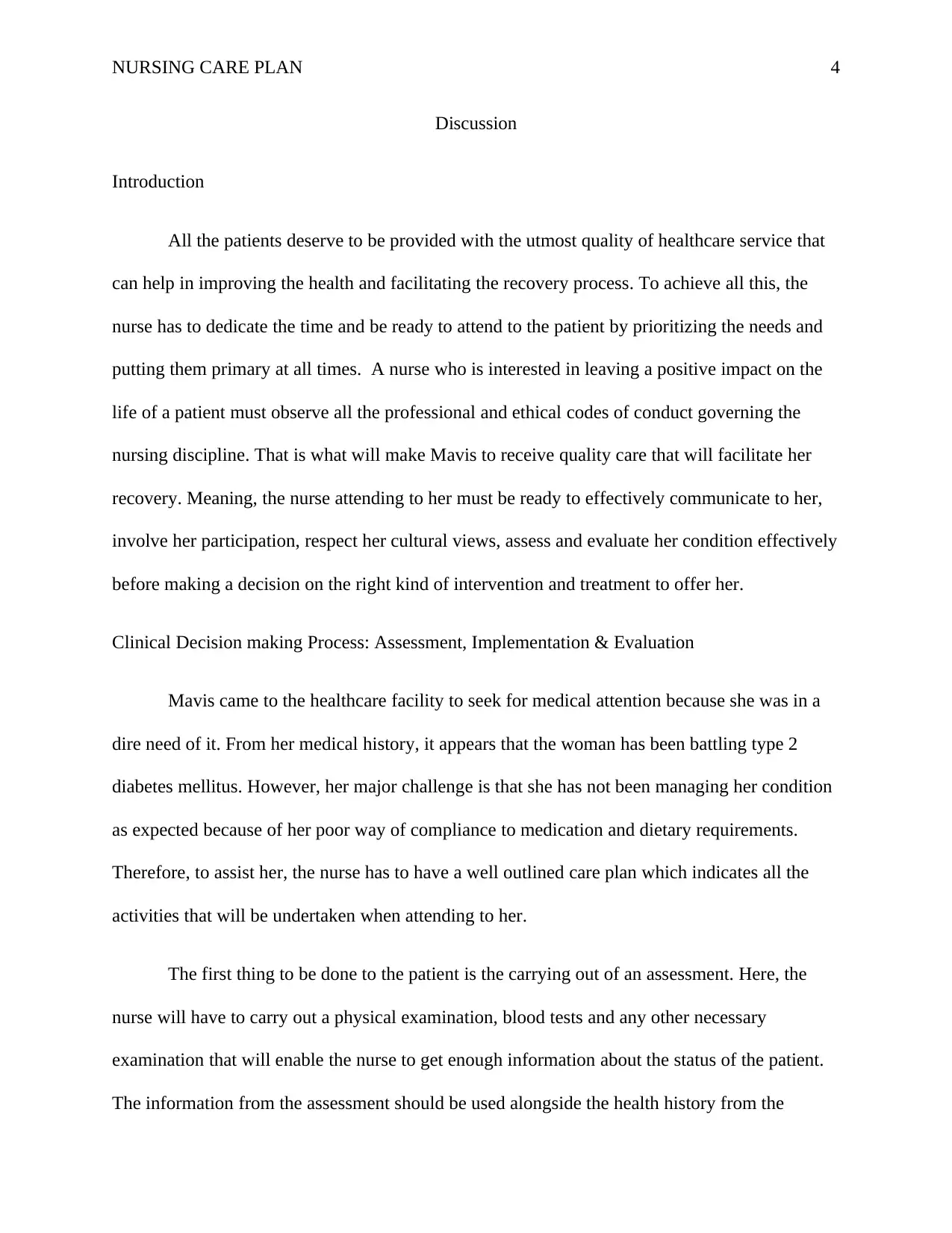
NURSING CARE PLAN 4
Discussion
Introduction
All the patients deserve to be provided with the utmost quality of healthcare service that
can help in improving the health and facilitating the recovery process. To achieve all this, the
nurse has to dedicate the time and be ready to attend to the patient by prioritizing the needs and
putting them primary at all times. A nurse who is interested in leaving a positive impact on the
life of a patient must observe all the professional and ethical codes of conduct governing the
nursing discipline. That is what will make Mavis to receive quality care that will facilitate her
recovery. Meaning, the nurse attending to her must be ready to effectively communicate to her,
involve her participation, respect her cultural views, assess and evaluate her condition effectively
before making a decision on the right kind of intervention and treatment to offer her.
Clinical Decision making Process: Assessment, Implementation & Evaluation
Mavis came to the healthcare facility to seek for medical attention because she was in a
dire need of it. From her medical history, it appears that the woman has been battling type 2
diabetes mellitus. However, her major challenge is that she has not been managing her condition
as expected because of her poor way of compliance to medication and dietary requirements.
Therefore, to assist her, the nurse has to have a well outlined care plan which indicates all the
activities that will be undertaken when attending to her.
The first thing to be done to the patient is the carrying out of an assessment. Here, the
nurse will have to carry out a physical examination, blood tests and any other necessary
examination that will enable the nurse to get enough information about the status of the patient.
The information from the assessment should be used alongside the health history from the
Discussion
Introduction
All the patients deserve to be provided with the utmost quality of healthcare service that
can help in improving the health and facilitating the recovery process. To achieve all this, the
nurse has to dedicate the time and be ready to attend to the patient by prioritizing the needs and
putting them primary at all times. A nurse who is interested in leaving a positive impact on the
life of a patient must observe all the professional and ethical codes of conduct governing the
nursing discipline. That is what will make Mavis to receive quality care that will facilitate her
recovery. Meaning, the nurse attending to her must be ready to effectively communicate to her,
involve her participation, respect her cultural views, assess and evaluate her condition effectively
before making a decision on the right kind of intervention and treatment to offer her.
Clinical Decision making Process: Assessment, Implementation & Evaluation
Mavis came to the healthcare facility to seek for medical attention because she was in a
dire need of it. From her medical history, it appears that the woman has been battling type 2
diabetes mellitus. However, her major challenge is that she has not been managing her condition
as expected because of her poor way of compliance to medication and dietary requirements.
Therefore, to assist her, the nurse has to have a well outlined care plan which indicates all the
activities that will be undertaken when attending to her.
The first thing to be done to the patient is the carrying out of an assessment. Here, the
nurse will have to carry out a physical examination, blood tests and any other necessary
examination that will enable the nurse to get enough information about the status of the patient.
The information from the assessment should be used alongside the health history from the
Paraphrase This Document
Need a fresh take? Get an instant paraphrase of this document with our AI Paraphraser
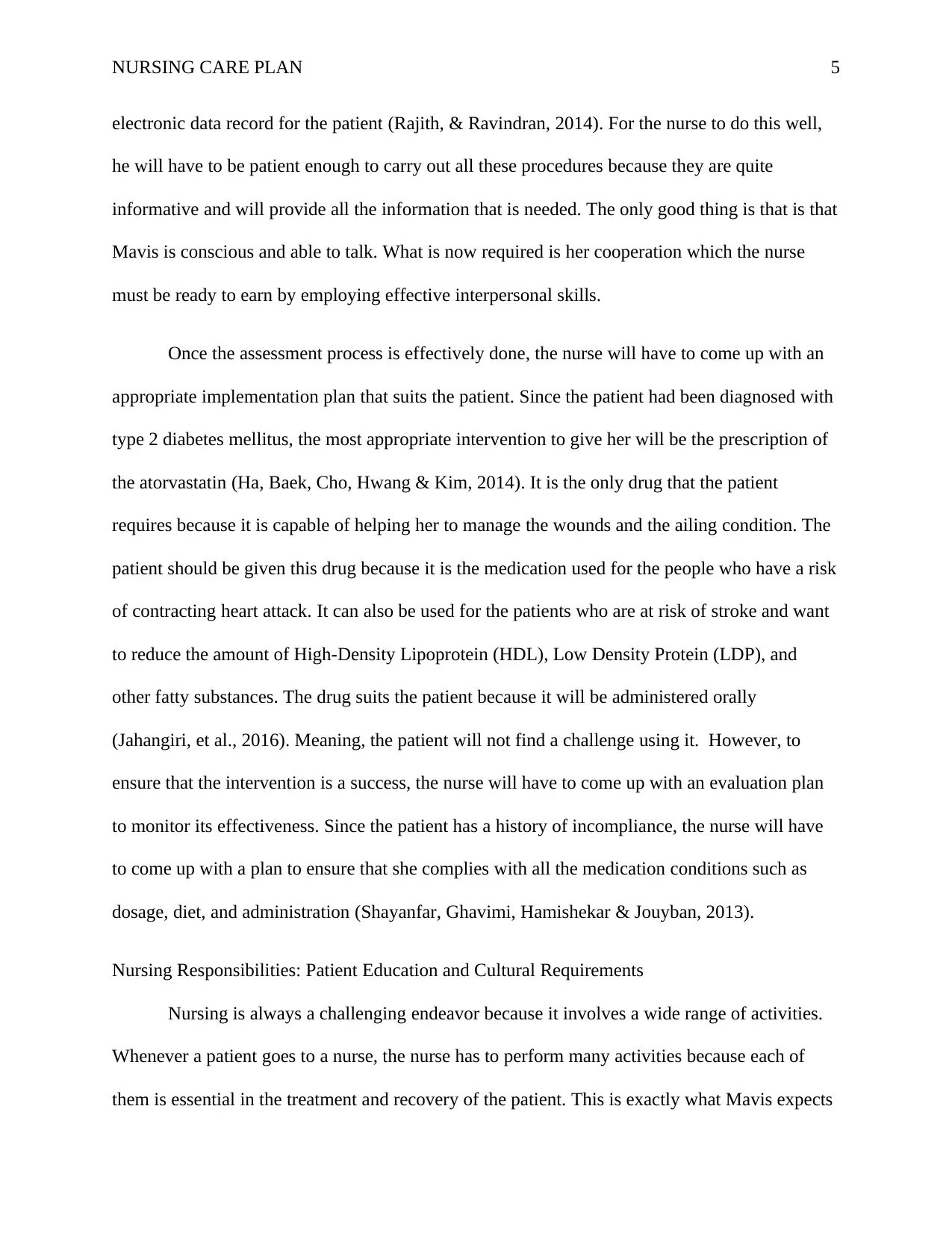
NURSING CARE PLAN 5
electronic data record for the patient (Rajith, & Ravindran, 2014). For the nurse to do this well,
he will have to be patient enough to carry out all these procedures because they are quite
informative and will provide all the information that is needed. The only good thing is that is that
Mavis is conscious and able to talk. What is now required is her cooperation which the nurse
must be ready to earn by employing effective interpersonal skills.
Once the assessment process is effectively done, the nurse will have to come up with an
appropriate implementation plan that suits the patient. Since the patient had been diagnosed with
type 2 diabetes mellitus, the most appropriate intervention to give her will be the prescription of
the atorvastatin (Ha, Baek, Cho, Hwang & Kim, 2014). It is the only drug that the patient
requires because it is capable of helping her to manage the wounds and the ailing condition. The
patient should be given this drug because it is the medication used for the people who have a risk
of contracting heart attack. It can also be used for the patients who are at risk of stroke and want
to reduce the amount of High-Density Lipoprotein (HDL), Low Density Protein (LDP), and
other fatty substances. The drug suits the patient because it will be administered orally
(Jahangiri, et al., 2016). Meaning, the patient will not find a challenge using it. However, to
ensure that the intervention is a success, the nurse will have to come up with an evaluation plan
to monitor its effectiveness. Since the patient has a history of incompliance, the nurse will have
to come up with a plan to ensure that she complies with all the medication conditions such as
dosage, diet, and administration (Shayanfar, Ghavimi, Hamishekar & Jouyban, 2013).
Nursing Responsibilities: Patient Education and Cultural Requirements
Nursing is always a challenging endeavor because it involves a wide range of activities.
Whenever a patient goes to a nurse, the nurse has to perform many activities because each of
them is essential in the treatment and recovery of the patient. This is exactly what Mavis expects
electronic data record for the patient (Rajith, & Ravindran, 2014). For the nurse to do this well,
he will have to be patient enough to carry out all these procedures because they are quite
informative and will provide all the information that is needed. The only good thing is that is that
Mavis is conscious and able to talk. What is now required is her cooperation which the nurse
must be ready to earn by employing effective interpersonal skills.
Once the assessment process is effectively done, the nurse will have to come up with an
appropriate implementation plan that suits the patient. Since the patient had been diagnosed with
type 2 diabetes mellitus, the most appropriate intervention to give her will be the prescription of
the atorvastatin (Ha, Baek, Cho, Hwang & Kim, 2014). It is the only drug that the patient
requires because it is capable of helping her to manage the wounds and the ailing condition. The
patient should be given this drug because it is the medication used for the people who have a risk
of contracting heart attack. It can also be used for the patients who are at risk of stroke and want
to reduce the amount of High-Density Lipoprotein (HDL), Low Density Protein (LDP), and
other fatty substances. The drug suits the patient because it will be administered orally
(Jahangiri, et al., 2016). Meaning, the patient will not find a challenge using it. However, to
ensure that the intervention is a success, the nurse will have to come up with an evaluation plan
to monitor its effectiveness. Since the patient has a history of incompliance, the nurse will have
to come up with a plan to ensure that she complies with all the medication conditions such as
dosage, diet, and administration (Shayanfar, Ghavimi, Hamishekar & Jouyban, 2013).
Nursing Responsibilities: Patient Education and Cultural Requirements
Nursing is always a challenging endeavor because it involves a wide range of activities.
Whenever a patient goes to a nurse, the nurse has to perform many activities because each of
them is essential in the treatment and recovery of the patient. This is exactly what Mavis expects
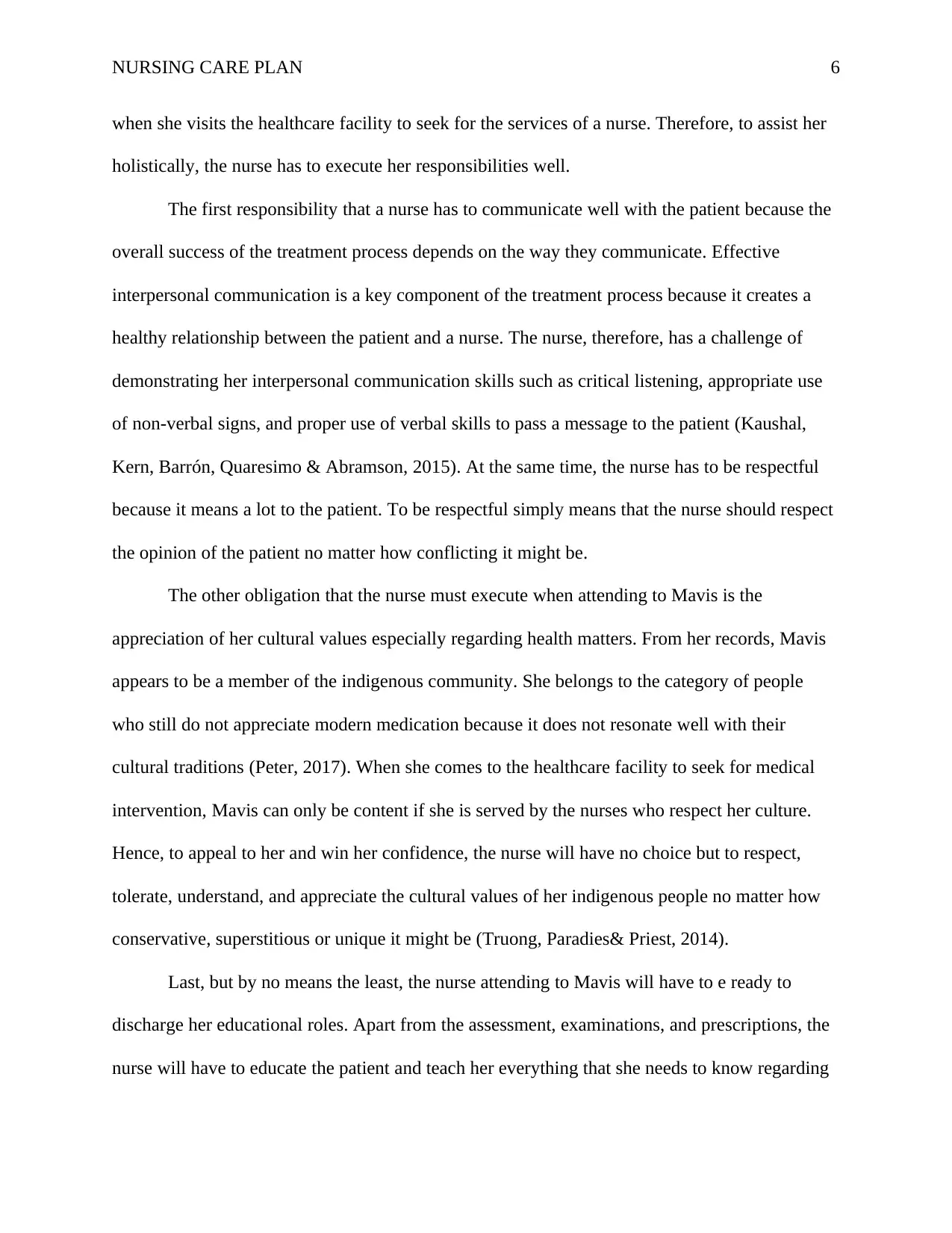
NURSING CARE PLAN 6
when she visits the healthcare facility to seek for the services of a nurse. Therefore, to assist her
holistically, the nurse has to execute her responsibilities well.
The first responsibility that a nurse has to communicate well with the patient because the
overall success of the treatment process depends on the way they communicate. Effective
interpersonal communication is a key component of the treatment process because it creates a
healthy relationship between the patient and a nurse. The nurse, therefore, has a challenge of
demonstrating her interpersonal communication skills such as critical listening, appropriate use
of non-verbal signs, and proper use of verbal skills to pass a message to the patient (Kaushal,
Kern, Barrón, Quaresimo & Abramson, 2015). At the same time, the nurse has to be respectful
because it means a lot to the patient. To be respectful simply means that the nurse should respect
the opinion of the patient no matter how conflicting it might be.
The other obligation that the nurse must execute when attending to Mavis is the
appreciation of her cultural values especially regarding health matters. From her records, Mavis
appears to be a member of the indigenous community. She belongs to the category of people
who still do not appreciate modern medication because it does not resonate well with their
cultural traditions (Peter, 2017). When she comes to the healthcare facility to seek for medical
intervention, Mavis can only be content if she is served by the nurses who respect her culture.
Hence, to appeal to her and win her confidence, the nurse will have no choice but to respect,
tolerate, understand, and appreciate the cultural values of her indigenous people no matter how
conservative, superstitious or unique it might be (Truong, Paradies& Priest, 2014).
Last, but by no means the least, the nurse attending to Mavis will have to e ready to
discharge her educational roles. Apart from the assessment, examinations, and prescriptions, the
nurse will have to educate the patient and teach her everything that she needs to know regarding
when she visits the healthcare facility to seek for the services of a nurse. Therefore, to assist her
holistically, the nurse has to execute her responsibilities well.
The first responsibility that a nurse has to communicate well with the patient because the
overall success of the treatment process depends on the way they communicate. Effective
interpersonal communication is a key component of the treatment process because it creates a
healthy relationship between the patient and a nurse. The nurse, therefore, has a challenge of
demonstrating her interpersonal communication skills such as critical listening, appropriate use
of non-verbal signs, and proper use of verbal skills to pass a message to the patient (Kaushal,
Kern, Barrón, Quaresimo & Abramson, 2015). At the same time, the nurse has to be respectful
because it means a lot to the patient. To be respectful simply means that the nurse should respect
the opinion of the patient no matter how conflicting it might be.
The other obligation that the nurse must execute when attending to Mavis is the
appreciation of her cultural values especially regarding health matters. From her records, Mavis
appears to be a member of the indigenous community. She belongs to the category of people
who still do not appreciate modern medication because it does not resonate well with their
cultural traditions (Peter, 2017). When she comes to the healthcare facility to seek for medical
intervention, Mavis can only be content if she is served by the nurses who respect her culture.
Hence, to appeal to her and win her confidence, the nurse will have no choice but to respect,
tolerate, understand, and appreciate the cultural values of her indigenous people no matter how
conservative, superstitious or unique it might be (Truong, Paradies& Priest, 2014).
Last, but by no means the least, the nurse attending to Mavis will have to e ready to
discharge her educational roles. Apart from the assessment, examinations, and prescriptions, the
nurse will have to educate the patient and teach her everything that she needs to know regarding
⊘ This is a preview!⊘
Do you want full access?
Subscribe today to unlock all pages.

Trusted by 1+ million students worldwide
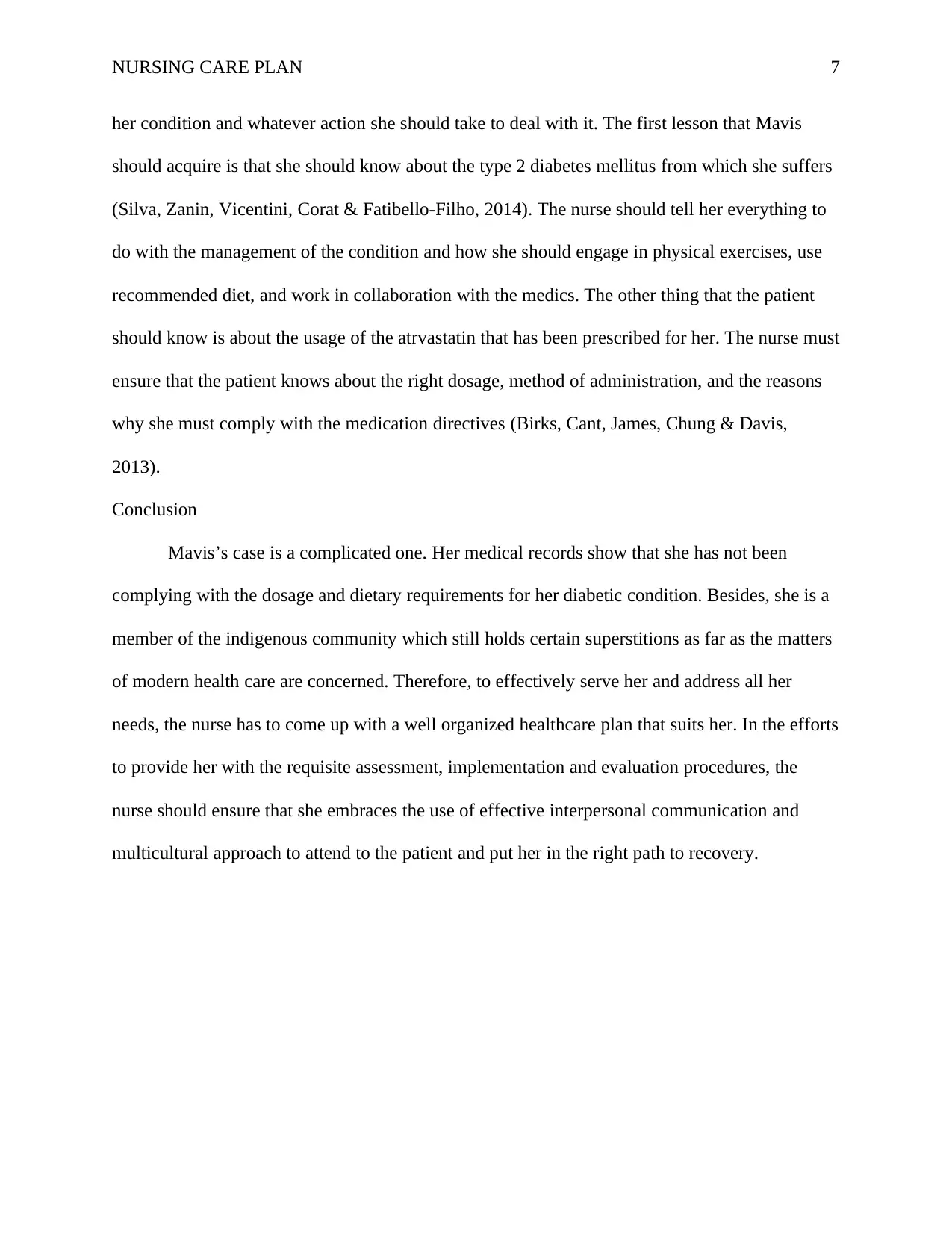
NURSING CARE PLAN 7
her condition and whatever action she should take to deal with it. The first lesson that Mavis
should acquire is that she should know about the type 2 diabetes mellitus from which she suffers
(Silva, Zanin, Vicentini, Corat & Fatibello-Filho, 2014). The nurse should tell her everything to
do with the management of the condition and how she should engage in physical exercises, use
recommended diet, and work in collaboration with the medics. The other thing that the patient
should know is about the usage of the atrvastatin that has been prescribed for her. The nurse must
ensure that the patient knows about the right dosage, method of administration, and the reasons
why she must comply with the medication directives (Birks, Cant, James, Chung & Davis,
2013).
Conclusion
Mavis’s case is a complicated one. Her medical records show that she has not been
complying with the dosage and dietary requirements for her diabetic condition. Besides, she is a
member of the indigenous community which still holds certain superstitions as far as the matters
of modern health care are concerned. Therefore, to effectively serve her and address all her
needs, the nurse has to come up with a well organized healthcare plan that suits her. In the efforts
to provide her with the requisite assessment, implementation and evaluation procedures, the
nurse should ensure that she embraces the use of effective interpersonal communication and
multicultural approach to attend to the patient and put her in the right path to recovery.
her condition and whatever action she should take to deal with it. The first lesson that Mavis
should acquire is that she should know about the type 2 diabetes mellitus from which she suffers
(Silva, Zanin, Vicentini, Corat & Fatibello-Filho, 2014). The nurse should tell her everything to
do with the management of the condition and how she should engage in physical exercises, use
recommended diet, and work in collaboration with the medics. The other thing that the patient
should know is about the usage of the atrvastatin that has been prescribed for her. The nurse must
ensure that the patient knows about the right dosage, method of administration, and the reasons
why she must comply with the medication directives (Birks, Cant, James, Chung & Davis,
2013).
Conclusion
Mavis’s case is a complicated one. Her medical records show that she has not been
complying with the dosage and dietary requirements for her diabetic condition. Besides, she is a
member of the indigenous community which still holds certain superstitions as far as the matters
of modern health care are concerned. Therefore, to effectively serve her and address all her
needs, the nurse has to come up with a well organized healthcare plan that suits her. In the efforts
to provide her with the requisite assessment, implementation and evaluation procedures, the
nurse should ensure that she embraces the use of effective interpersonal communication and
multicultural approach to attend to the patient and put her in the right path to recovery.
Paraphrase This Document
Need a fresh take? Get an instant paraphrase of this document with our AI Paraphraser
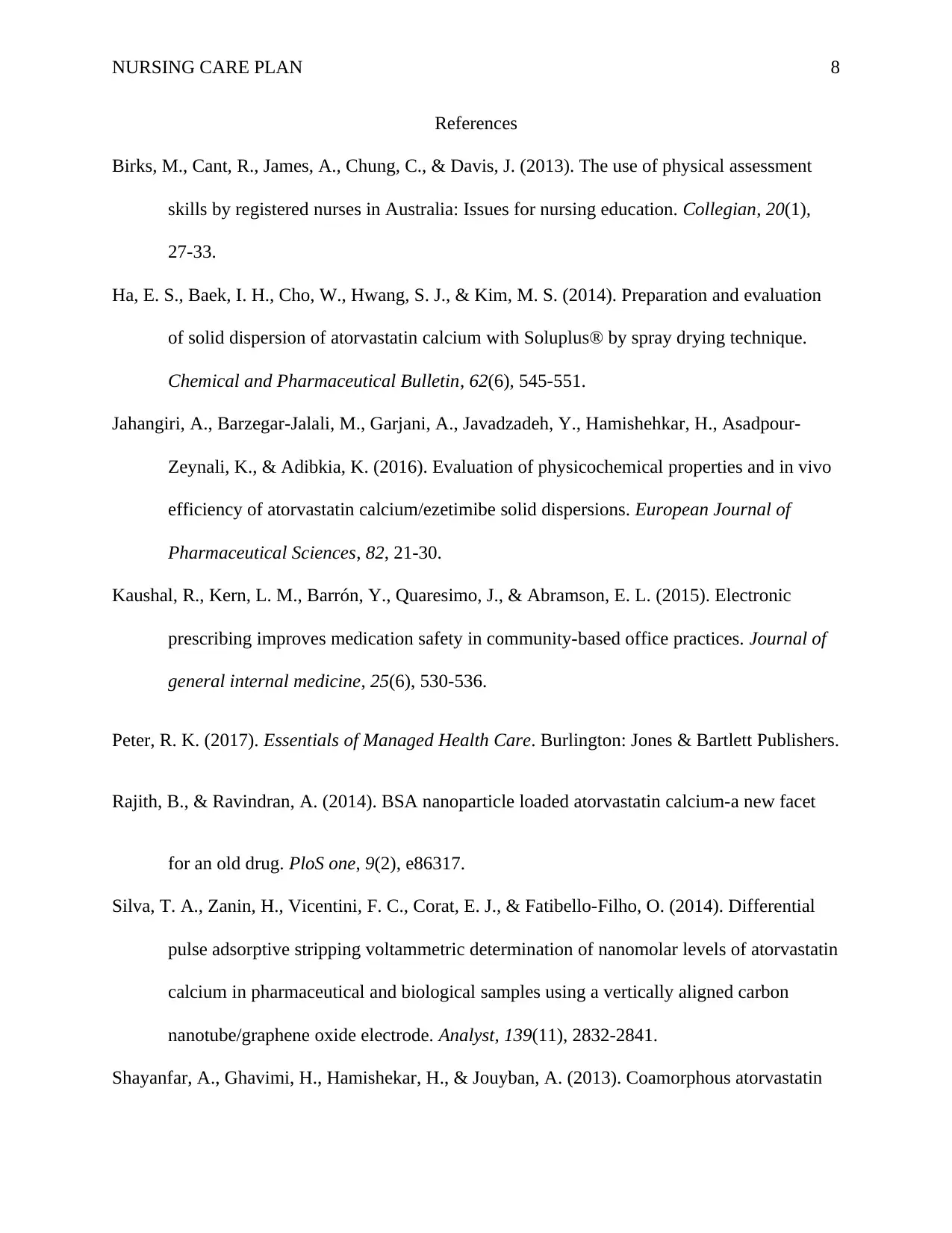
NURSING CARE PLAN 8
References
Birks, M., Cant, R., James, A., Chung, C., & Davis, J. (2013). The use of physical assessment
skills by registered nurses in Australia: Issues for nursing education. Collegian, 20(1),
27-33.
Ha, E. S., Baek, I. H., Cho, W., Hwang, S. J., & Kim, M. S. (2014). Preparation and evaluation
of solid dispersion of atorvastatin calcium with Soluplus® by spray drying technique.
Chemical and Pharmaceutical Bulletin, 62(6), 545-551.
Jahangiri, A., Barzegar-Jalali, M., Garjani, A., Javadzadeh, Y., Hamishehkar, H., Asadpour-
Zeynali, K., & Adibkia, K. (2016). Evaluation of physicochemical properties and in vivo
efficiency of atorvastatin calcium/ezetimibe solid dispersions. European Journal of
Pharmaceutical Sciences, 82, 21-30.
Kaushal, R., Kern, L. M., Barrón, Y., Quaresimo, J., & Abramson, E. L. (2015). Electronic
prescribing improves medication safety in community-based office practices. Journal of
general internal medicine, 25(6), 530-536.
Peter, R. K. (2017). Essentials of Managed Health Care. Burlington: Jones & Bartlett Publishers.
Rajith, B., & Ravindran, A. (2014). BSA nanoparticle loaded atorvastatin calcium-a new facet
for an old drug. PloS one, 9(2), e86317.
Silva, T. A., Zanin, H., Vicentini, F. C., Corat, E. J., & Fatibello-Filho, O. (2014). Differential
pulse adsorptive stripping voltammetric determination of nanomolar levels of atorvastatin
calcium in pharmaceutical and biological samples using a vertically aligned carbon
nanotube/graphene oxide electrode. Analyst, 139(11), 2832-2841.
Shayanfar, A., Ghavimi, H., Hamishekar, H., & Jouyban, A. (2013). Coamorphous atorvastatin
References
Birks, M., Cant, R., James, A., Chung, C., & Davis, J. (2013). The use of physical assessment
skills by registered nurses in Australia: Issues for nursing education. Collegian, 20(1),
27-33.
Ha, E. S., Baek, I. H., Cho, W., Hwang, S. J., & Kim, M. S. (2014). Preparation and evaluation
of solid dispersion of atorvastatin calcium with Soluplus® by spray drying technique.
Chemical and Pharmaceutical Bulletin, 62(6), 545-551.
Jahangiri, A., Barzegar-Jalali, M., Garjani, A., Javadzadeh, Y., Hamishehkar, H., Asadpour-
Zeynali, K., & Adibkia, K. (2016). Evaluation of physicochemical properties and in vivo
efficiency of atorvastatin calcium/ezetimibe solid dispersions. European Journal of
Pharmaceutical Sciences, 82, 21-30.
Kaushal, R., Kern, L. M., Barrón, Y., Quaresimo, J., & Abramson, E. L. (2015). Electronic
prescribing improves medication safety in community-based office practices. Journal of
general internal medicine, 25(6), 530-536.
Peter, R. K. (2017). Essentials of Managed Health Care. Burlington: Jones & Bartlett Publishers.
Rajith, B., & Ravindran, A. (2014). BSA nanoparticle loaded atorvastatin calcium-a new facet
for an old drug. PloS one, 9(2), e86317.
Silva, T. A., Zanin, H., Vicentini, F. C., Corat, E. J., & Fatibello-Filho, O. (2014). Differential
pulse adsorptive stripping voltammetric determination of nanomolar levels of atorvastatin
calcium in pharmaceutical and biological samples using a vertically aligned carbon
nanotube/graphene oxide electrode. Analyst, 139(11), 2832-2841.
Shayanfar, A., Ghavimi, H., Hamishekar, H., & Jouyban, A. (2013). Coamorphous atorvastatin
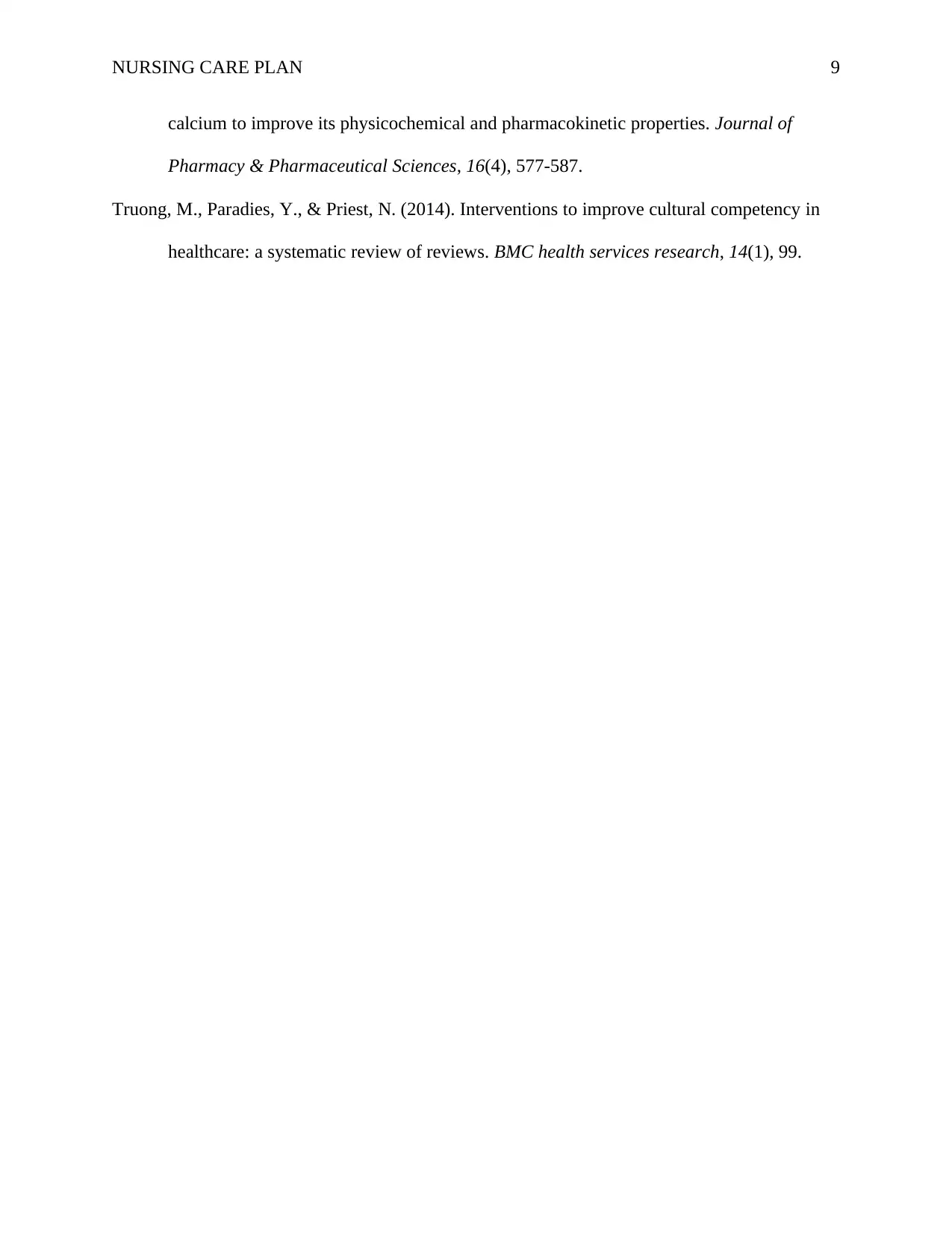
NURSING CARE PLAN 9
calcium to improve its physicochemical and pharmacokinetic properties. Journal of
Pharmacy & Pharmaceutical Sciences, 16(4), 577-587.
Truong, M., Paradies, Y., & Priest, N. (2014). Interventions to improve cultural competency in
healthcare: a systematic review of reviews. BMC health services research, 14(1), 99.
calcium to improve its physicochemical and pharmacokinetic properties. Journal of
Pharmacy & Pharmaceutical Sciences, 16(4), 577-587.
Truong, M., Paradies, Y., & Priest, N. (2014). Interventions to improve cultural competency in
healthcare: a systematic review of reviews. BMC health services research, 14(1), 99.
⊘ This is a preview!⊘
Do you want full access?
Subscribe today to unlock all pages.

Trusted by 1+ million students worldwide
1 out of 9
Related Documents
Your All-in-One AI-Powered Toolkit for Academic Success.
+13062052269
info@desklib.com
Available 24*7 on WhatsApp / Email
![[object Object]](/_next/static/media/star-bottom.7253800d.svg)
Unlock your academic potential
Copyright © 2020–2025 A2Z Services. All Rights Reserved. Developed and managed by ZUCOL.





